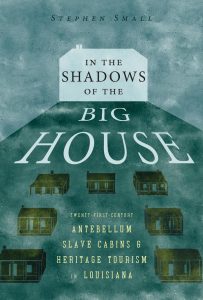Book Review: In the Shadows of the Big House: Twenty-First Century Antebellum Slave Cabins and Heritage Tourism in Louisiana

 In the Shadows of the Big House: Twenty-First Century Antebellum Slave Cabins and Heritage Tourism in Louisiana. By Stephen Small. Jackson, MS: University Press of Mississippi, 2023. Softcover, 270 pp. $30.00.
In the Shadows of the Big House: Twenty-First Century Antebellum Slave Cabins and Heritage Tourism in Louisiana. By Stephen Small. Jackson, MS: University Press of Mississippi, 2023. Softcover, 270 pp. $30.00.
Reviewed by Cecily Zander
As the readers at Emerging Civil War well know, touring historic sites related to the Civil War era could keep anyone occupied for a lifetime (how you all find the time to read this blog in between your trips we may never know). The heritage tourism industry of the American South’s former plantations is an integral adjunct to the many battlefields and historic homes dotted across the Civil War landscape. This subset of tourism—focusing on the lives of the white men and women who owned stately homes and oversaw extensive agricultural operations, as well as on the enslaved Black women and men who labored at those sites—is increasingly under scrutiny, as public historians and archivists seek to tell the complete story of life at these locations before the Civil War.
Stephen Small’s In the Shadows of the Big House joins this ongoing effort by examining the sites of sixteen slave cabins in the Natchitoches Parish of Louisiana—located at the Oakland Plantation, the Magnolia Planation, and the Melrose Plantation. Both the Oakland Plantation and the Magnolia Plantation are currently owned and operated as units of the National Park Service. The Melrose Plantation is owned and operated by the Association for the Preservation of Historic Natchitoches and plays a unique role in the story of the region’s history, as a planation built and operated by free Blacks. Small provides brief and illuminating histories of each of the three plantations, from their individual founding stories through their existence well into the twentieth century, prior to their conversion to heritage sites.
The slave cabins at the various Natchitoches plantations, Small argues, “are the physical and institution embodiment of social forgetting and social remembering” (176). The most important aspect of Small’s book is in its intense examination of how slave cabins can be fully incorporated into the story of slavery. Small observes that much of heritage tourism caters to a white audience, and, as a result, the experiences of enslaved people have been less likely to be foregrounded in the ways plantation sites interpret their history. Small would challenge these sites to embrace complexity and to give more attention to the places where the majority of individuals who were forced to occupy plantation spaces lived and worked.
Readers interested in how the tourism industry and public memory of the Civil War have developed will find In the Shadows of the Big House worth reading. Readers expecting a traditional historical narrative will be disappointed, though the author is clear that recapitulating the history of these plantation spaces was not his intention. It would not be surprising to see more work analyzing and critiquing nineteenth-century historic sites appear following this work. This is an area ripe for study—in a moment when there seems to be increasing opportunity for academic and public historians to work together to advance popular understanding of history. This well-written and thoughtful book is an excellent start.
I recommend “Charting the Plantation Landscape from Natchez to New Orleans”, a collection of academic essays that covers the same ground, but is specific to the plantations along the lower Mississippi river. From LSU Press better than Ole Miss Press. The landscape, as they authors describe it, is mostly devoid of original slave and overseer cabins, and many sugar/cotton production buildings. I picked this book up while visiting Laura Plantation where they are known to cover the enslaved experience well: a tour there is about 50-50 between planter class and enslaved/other class. At Houmas House they actually encourage people to visit Laura Plantation to learn more about the slave experience since they have, if not original slave cabins, replicas. Of course the slave cabins aren’t located where they were actually located which was a mile or so farther back from the river and away from the “big house”, but they are there for people to walk through, sit in, and learn about.
The free black slave owners of Natchitoches I learned about more than two decades ago in William J. Coopers antebellum South history class at LSU. They aren’t totally unique to the Natchitoches/Cane River area, Louisiana, or even in South Carolina, but they are obviously an interesting outlier to the white supremacy of the era and the white planter class. They apparently tried to purchase their own familial relations whenever possible and I believe they offered their services to the Confederacy at some point, but were turned down because they weren’t white.